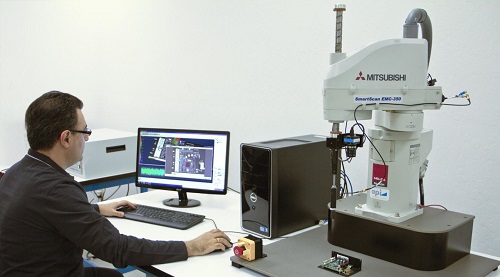
SOLUTION
- EMC test machine with
- RV-3SD 6-axis Robot
ADVANTAGES
- Improved accuracy and repeatability
- Reduced set-up time
- Higher quality
BENEFITS
- Improved customer satisfaction
- Improved reliability
Challenge
Electromagnetic Compatibility (EMC) testing and compliance is regarded as one of the final gates to successful electronics design and release to market. Headquartered in California’s Silicon Valley, Amber Precision Instruments (API) services this need by developing small-scale EMC test stations.
In 2006, API’s technology employed a vertical X-Y gantry motion subsystem incorporating stepper motors, worm gears and custom-made parts. The multi-vendor design was complex to set up and program and was also noisy and slow in operation. The mechanical design posed inherent challenges to wiring and final assembly, and the resulting system saw limits to accuracy, reliability and performance. Although API’s proprietary measurement software provided a powerful toolset, the mechanical system was not optimized and would not accommodate anticipated technical growth requirements including TACT (Turn Around Cycle Time) and DUT (Device Under Test) sampling resolution.
Background
Amber Precision Instruments is a private corporation that manufactures EMI (Electromagnetic Interference) and ESD (Electrostatic Discharge) scanners to help electronics suppliers comply with EMC regulations and directives. Samsung, LG and Intel are among some of API’s Tier 1 customers that use these scanner systems. When API began researching methods to improve their machine accuracy and reliability in late 2009, the engineering team naturally turned to robots. The cost savings from reduced installation and programming times would help offset the upfront cost of the robots as a sub-system. Furthermore, streamlined multi-axis control facilitates a more accurate method of delivering data to customers.
Solution
In early 2010, after discovering Mitsubishi Electric Automation’s industrial robot offering along with their technical sales support and field engineering services in North America, API decided to purchase the vertically articulated 6-axis RV-3SD for their SmartZap ESD test station. This stand-alone robot provided an opportunity to test a solution in lieu of their complicated X-Y gantry system. The fully automated SmartZap uses 5 cameras to define the geometry of a DUT (typically a PCB, mobile phone, or tablet) allowing the software to calculate 3D points for testing. The RV-3SD robot, equipped with TCP/IP communication, then receives discrete move commands from the software to position an ESD gun or finger emulator to specific locations on the DUT. The end result is a comprehensive data map with localized ESD characterization information.
Results
Mitsubishi Electric’s robot technology has provided improved accuracy and repeatability along with helping to reduce machine setup time from 1 week to 1 day.
Partnering with Mitsubishi Electric has also played a role in improving API’s credibility with their current and prospective clients through offering an attractive solution that comes with a high quality product, backed by a 2-year warranty. Mitsubishi is also a world renowned automation vendor with service and support centers located all around the globe. Giorgi Muchaidze, Manager of System Integration at API, commented, “Changing to Mitsubishi allowed us to not only catch up to, but surpass our competition in performance and quality.”
According to Jin Min, Director of Operations at API, industrial automation will play a larger role for EMC testing in the future, and API is optimistic to engineer even more powerful systems that utilize this technology.
Seeing the value from the first 6-axis robot, API followed suit with two different models of 4-axis SCARA (Selective Compliant Assembly Robot Arm) robots from Mitsubishi for their SmartScan system. The SmartScan system is available for ESD and EMI testing and remains one of API’s best-selling products.

